Isoetid
Appearance

Isoetids are aquatic plants or wetland plants named for their superficial similarity to the quillworts, Isoetes. They occur in wetlands and on shorelines with low nutrient availability.[1] Owing to their slow growth rates, they are also often found in areas with low rates of sediment deposition.[2] Many have evergreen leaves, and CAM photosynthesis.[3] Often they are exposed during periods of low water. Common examples include Lobelia dortmanna and Eriocaulon aquaticum.
Lobelia dortmanna
Eriocaulon aquaticum
References
[edit]- ^ Keddy, P.A. (2010). Wetland Ecology: Principles and Conservation. Cambridge University Press, Cambridge, UK. p. 26.
- ^ Pearsall, W. H. (1920). The aquatic vegetation of the English Lakes. Journal of Ecology, 8, 163–201.
- ^ Boston, H. L. (1986). A discussion of the adaptation for carbon acquisition in relation to the growth strategy of aquatic isoetids. Aquatic Botany, 26, 259–70.


